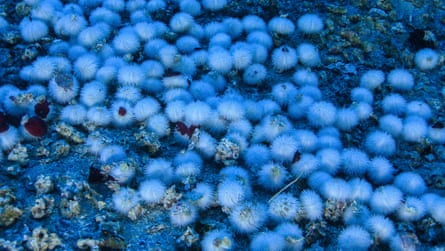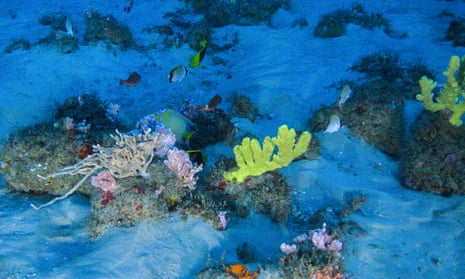There is a flickering, bright glimmer of sky as the two-person submarine descends beneath the muddy equatorial waters to a place no human has ever seen – a vast, complex coral reef at the mouth of the world’s greatest river.
Thirty metres under the murky plume of the sediment-heavy Amazon, the sub enters a darker, richer world. A school of curious remora fish approaches the two-tonne machine. Crabs and starfish loom in its eerie lights. A metre-long amberjack swims past, then a two-metre ray.
At a depth of 80 metres, the pilot pauses to record large mounds of coral covered in rainbow-coloured pygmy angelfish, wrasses and parrotfish. There are sponges 30ft long.
At 120 metres the sub settles on the nearly level ocean floor in a field of soft coral, sea whips and fans. The pilot manoeuvres its remote cameras to within inches of the reef wall. It consists mainly of sponges and colourful rhodolith beds – masses of coral-like red algae – which are formed by chemical synthesis and thrive in the low light.
Most of the world’s shallow reefs are in trouble due to bleaching, climate change and fishing, but this one is pristine. Its wall is full of minute grooves and cracks, each hole and fissure home to something alive. Small, brave crabs approach the sub and raise their claws as if to defend themselves against this alien monster.
There are four Brazilian oceanographers, ecologists and marine scientists taking turns to dive in the sub from the Greenpeace boat Esperanza. For them, the chance to observe the reef, which they and others discovered three years ago after dredging brought up corals, is as thrilling as winning the World Cup.
Last year, based on chemical analysis of the plume and measurements of oxygen levels, they estimated the reef to be about 600 miles long, to cover 3,600 square miles, and be about 30 to 120 metres deep. They thought it was biologically relatively impoverished compared to other equatorial reefs, but nevertheless they recorded more than 60 species of sponge, 73 species of fish, spiny lobsters, stars and other reef life.
Their find left marine ecologists flabbergasted. There is no record of any coral reef at the mouth of a major river because sunlight can barely penetrate the plume of sediment, so photosynthesis, the driver of most coral reefs, cannot happen. “We found a reef where the textbooks said there shouldn’t be one. We think it is unique,” said Fabiano Thompson, an oceanographer of the Federal University of Rio de Janeiro on board the Esperanza.

Now, in a handful of dives, they must totally revise their findings, he said. “We have identified at least three new fish species, seen possibly 40 species new to the area, found large numbers of critically endangered fish, and a corridor through the reef allowing fish to pass from the Caribbean through to southern Brazil.
“Not only is the reef far deeper and richer than what we thought, it is bigger and far more important to science,” said Thompson. “It is a megabiome, a major ecological community of plants and animals with its own endemic species. This makes everything we published out of date. We are rewriting the textbooks.”
Ronaldo Francini-Filho, an ecologist from Paraíba University, said: “We have realised quickly that our knowledge is completely out of date. In just one dive we counted double the number of species that we thought were here. We thought it was a scattered reef with about 20 species. Now we know it is maybe three times the size and has possibly hundreds of species. It is gigantic. We are talking of something of global significance.

“I have dived 6,000 times and I have never seen anything like this. On a scale between interesting and amazing, this is beyond believable. We can definitely say it is a hotspot of biodiversity, on the same level as the Great Barrier Reef. It is far deeper than we ever expected, and far richer in species. Yet we have barely scratched the surface.”
“Its discovery raises so many questions. We want to know how it functions, and what are its environmental drivers. This could rewrite the ecology of the whole Amazon. We must now see the river, the forest and the reef working together, interconnected, and making up the richest biodiversity in the world – a mega biome,” said Francini-Filho.
But the scientists are now racing the oil companies. Even as the Amazon reef is found and gives up its secrets, BP, Total and Brazilian oil companies are preparing to start exploratory drilling for what they estimate to be 15-20bn barrels of oil at depths of more than 1,000 metres. The Brazilian government has already licensed 80 blocks off the coast of Amapá, with the closest just five miles from the reef.
For Greenpeace, which has paid for the submarine to allow the scientists to explore the reef ahead of any drilling, the stakes are equally high. “This is oil’s new frontier and we must stop the oil being exploited. This oil must never be used. The reef is a natural wonder of the world. We cannot open up this new frontier if we want to keep temperatures to 1.5C [above pre-industrial levels],” said Thiago Almeida, a Greenpeace campaigner.

“This biome may change our understanding of reefs, even the oceans. If there is one reef here, where else are they? On scientific grounds alone they should not be allowed to drill. There is always the risk of another oil spill. Imagine what would happen here if there was contamination. It would wreck the reef, kill the coast and the largest mangrove forest in the world,” he said.
BP says its drilling would not affect the reef, and that any spill would be swept by currents away from the land.
In a statement to the Guardian, it said: “BP operates one block, and has non-operating interests in others operated by Total. The BP-operated block is about 160km (100 miles) offshore in water depths between 2.4 and 3.4km. The reef system that is described in the 2016 study is in much shallower water and approximately 35km distant from the BP block.
“BP expects to begin exploratory drilling operations before August 2018. There is no certainty that any commercial quantities of oil will be discovered by this exploration. The initial exploration phase would be expected to be short term and onshore activity would primarily involve only supporting the transport and change of the crew of the drilling rig via the existing airport in Oiapoque.”
“BP’s primary focus is on the prevention of oil spills. Drilling operations will only begin after a drilling licence is granted by Ibama [the Brazilian environment agency]. Our analysis shows that, even in a worst case scenario, there is a very high probability that any oil would flow away from the reef area,” said the company.
Getting permission to drill will not be easy, said Silvana Grott, a spokeswoman for the independent Brazilian government public prosecutor in Macapá, the capital of the state of Amapá which is closest to the reef.

“We are investigating. We want more information from BP, Total and Ibama. We will look very closely at what they say and then consult our specialist experts. The oil companies have said there will be no impact on the reef but we are worried about pollution. They have not told us about possible direct and indirect effects on the reef or on land, or about their ability to clean up a spill,” she said.
“We start friendly. If necessary this will move to the courts. We have the power to stop the drilling. It could take BP and Total a long time, but we hope to resolve this by the end of 2017.”
Thompson says he would hate to see the pristine reef he and others discovered polluted by oil. “Can oil companies operate with a reef like this so close? I think not. We must do everything to ensure that no oil ever approaches the coral.”
